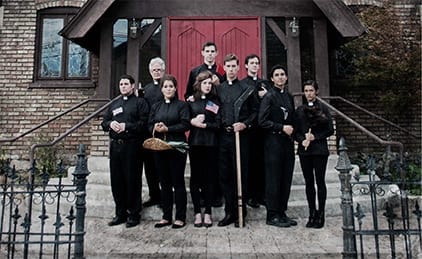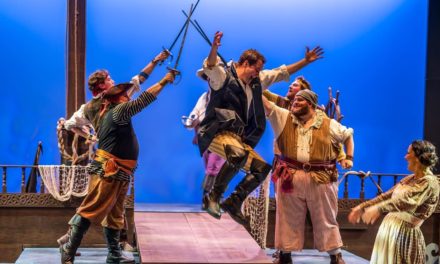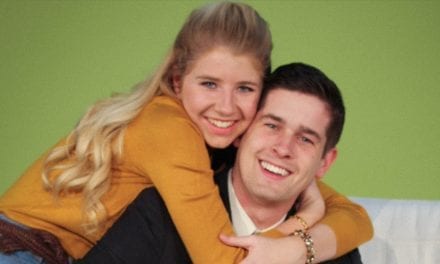PROVO — See How They Run by Philip King is a classic farce about the Toops, a vicar and his uncouth wife living in a small English hamlet during World War II. Things get tricky when the vicarage has a number of unexpected guests show up all at once, including a nosy neighbor, a Russian prisoner of war, Mrs. Toop’s old USO buddy of Mrs. Toop’s, her father-in-law (who also happens to be a bishop), and a bumbling vicar from out-of-town. Things get complicated with all of the random visitors, but it all comes to a head when at least five people end up dressed as priests, with no one really knowing what is going on.
The current production at BYU, directed by Barta Heiner, started out feeling choppy and rough, but by the second act, the cast found their stride and delivered a hilarious finish to an overall great show. Part of this might also be due to the script’s basic farcical structure, which tends to use the first act as more of a set-up for the high-energy conclusion of the second act. Regardless, the first act had some timing issues, a number of line flubs, and a number of punch lines that didn’t land quite right. But the second act was magnificently different, running like a well-oiled machine. Most impressive was the timing of the vast amount of physical comedy in the second act. There was a marked increase in the amount of physical humor, and the cast really seemed to thrive in the high energy chase scenes and pratfalls.
 While the entire cast did quite well, there were a couple of performances that really stuck out. Ann Lopez as the pious Miss Skillon was a dominating force in the first act. She was constantly fully engaged in every scene and found ways to push the comedy into that delightful zone of the ridiculous. Her reactions were priceless and well timed. Though much of her blocking involved her being passed out and acting like a rag-doll, Lopez was able to find ways add additional little “punch lines” of sorts.
While the entire cast did quite well, there were a couple of performances that really stuck out. Ann Lopez as the pious Miss Skillon was a dominating force in the first act. She was constantly fully engaged in every scene and found ways to push the comedy into that delightful zone of the ridiculous. Her reactions were priceless and well timed. Though much of her blocking involved her being passed out and acting like a rag-doll, Lopez was able to find ways add additional little “punch lines” of sorts.
Alex Diaz as Corporal Clive Winston and Ali Kinkade as Penelope Toop had great chemistry together on stage. It was easy to believe that they were old friends, but they also punctuated their relationship with aspects of the brutally honest type of friendship. Together, the created a feeling of wholeness to their relationship.
Noelle Houston’s portrayal of the cockneyed servant Ida was also a treat to watch. Houston was able to keep the character light and funny, but also found ways to add a fair amount of depth. Houston had great levels in her character that allowed her to be crusty, while being love-sick, while feeling bewildered, all while showing a sweet and caring side. It should also be noted that Rodger Sorensen’s performance as the Bishop of Lax served as a calming influence. Often the high-speed pacing of a farce can leave the audience feeling tired. Sorensen’s pacing was different from the rest of the cast, which can be dangerous territory. But in this case, it allowed the show to slow down occasionally so the audience could catch their breath before plunging back into the foray.
However, the best performance of the night was the show-stealing Jordan Nicholes as the Reverend Arthur Humphries. Nicholes’s character is the outsider that is thrust into this odd community and must adapt to survive. Nicholes had a wonderfully realistic style of comedy that was accented by perfect timing. No matter what ridiculous situation he was put in, it was easy to see why Rev. Humphrey acted the way he did, and Nicholes always performed with the most hilarious type of seriousness. This made Rev. Humphrey one of the funniest and yet most sympathetic characters in the show.
Other than the choppy first act, the only other major drawback of the show was the British accents. The accents were necessary for the characters and the setting, but they tended to be inconsistent across the cast and for each character. Even the more consistent accents tended to get in the way. For example Houston’s cockney was one of the best in the show, but sometimes it was almost too thick. Though accurate, it sometimes impeded communication in an unintended way.
The technical aspects of the play were wonderful. The set (designed by Logan Hayden) was gorgeous and provided a number of acting spaces that helped to keep the action from being cluttered all in one area. The lighting (designed by Mckenzie Ottley) was simple but beautiful, especially the well-designed night scene at the beginning of act two. The costumes (designed by Marissa Pack) and props (designed by Travis Coyne) were effective and seemed accurate to the time period.
There was one technical aspect that was a little distracting: the program. The show’s dramaturg, Abram Yarbro, put a lot of interesting info into the study guide that helped the audience to appreciate the show. However, there were also a number of quotes from the script, and they were all punch lines. This ruined those jokes for me. When a published line came around in the course of the show, I found myself anticipating the joke, and it lessened the humor. I am fully aware of how nit-picky this must sound, but it actually did distract me.
Through it all, this was a great performance. The script holds up extremely well after 70 years, especially with a talented group of actors working with it. Though there are some challenges with this production, they really are overshadowed by a solid second act that will had me laughing almost non-stop. I recommend catching this show before it runs away.






